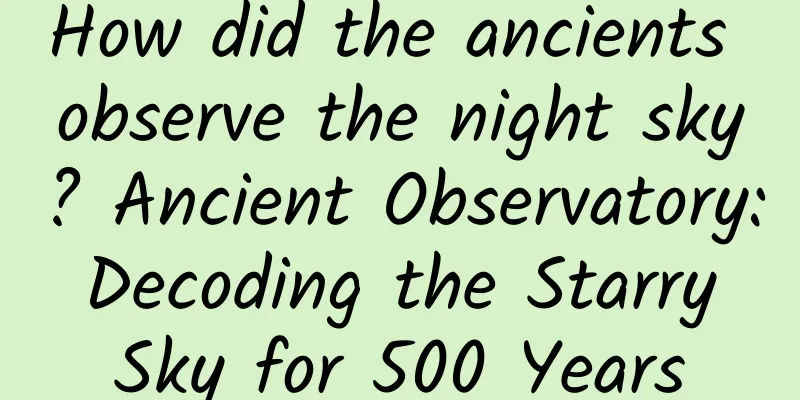How did the ancients observe the night sky? Ancient Observatory: Decoding the Starry Sky for 500 Years

|
Have you ever looked up at the starry sky and wanted to explore the mysterious universe? As early as more than 500 years ago, the Beijing Ancient Observatory was already a frontier of astronomy. It was the "laboratory" for ancient people to explore the universe, and now it has become a window for us to peek into the ancient scientific and technological wisdom. As the royal astronomical observation center of the Ming and Qing dynasties, it observed changes in the starry sky for 487 consecutive years. From a distance, it looks like an ancient castle surrounded by modern high-rise buildings. The platform is 14 meters high, and the top is unobstructed on all sides, providing a 360-degree open field of view to ensure observation accuracy. As you approach, you will see eight bronze astronomical instruments on the top of the platform, each weighing two or three tons. They were the most advanced scientific equipment at the time. You can see that most of the instruments are made up of circles, arc segments and straight line segments, which are simple and exquisite. Behind these basic geometric elements lies the wisdom of ancient astronomy. Let's reveal them one by one. 1. The celestial globe is a sphere that intuitively displays the distribution of stars, like an ancient " universal panorama model " that can be used to retrieve star images and convert spherical coordinates. The sphere, which is more than two meters in diameter, is inlaid with 1,888 stars, which are divided into six different sizes according to their brightness levels. 2. The equatorial theodolite is composed of several circles, namely the meridian circle, right ascension circle, and equatorial circle. The right ascension circle can rotate, and a dragon with its head held high holds them up. It is used to measure the equatorial longitude and latitude of celestial bodies, similar to the ancient " astronomical map" , which helps the ancients find the position of stars in the sky. It is mainly used to observe stars other than the sun, those relatively distant celestial bodies. As for the sun, there is an instrument specifically designed to observe it: 3. The ecliptic theodolite is composed of the meridian circle, ecliptic circle, ecliptic longitude circle, and polar circle, and is supported by two dragons facing back to back. The ecliptic is the path that the sun moves across the sky in a year. It is like the sun's "exclusive orbit recorder" , mainly measuring the movement of the sun and planets. It helped the ancients understand the changes of the sun in the sky throughout the year and determine the twenty-four solar terms. 4. The main body of the horizontal meridian instrument is a horizontal circle with a diameter of more than two meters. Two dragons are circling up along the pillars, holding a fire bead in their claws, like two dragons playing with a bead. When using it, two lines are drawn from the upper end of the vertical table (the vertical copper column) to the two ends of the horizontal table. When measuring stars, move the horizontal table so that the three lines and the stars are in the same plane, so that the measurement value can be read. It measures the longitude of a celestial body, or its direction above the horizon, helping people understand in which direction the sun and stars rise and set. 5. The horizontal theodolite can measure not only the azimuth, but also the altitude. It can tell you the horizontal and vertical heights of stars. It can tell you not only the position of a celestial body on the horizon, but also how high it appears from the ground. On the scale, you can find that it already uses Arabic numerals. 6. The time-limit instrument is also called the distance meter. The core technology is a mechanical device that can move in three dimensions. Its arc is 60 degrees. The pattern on it not only has a decorative effect, but also can adjust the balance so that the center of gravity is exactly on the vertical axis. It can rotate around the vertical axis at will, and the handwheel, gear, and pulley can be used to drive the instrument to move freely. This principle is similar to the base structure of modern astronomical telescopes, making observations more flexible and accurate. This instrument can measure the angular distance within 60 degrees between any two stars, helping astronomers to accurately draw star maps. It was quite advanced at the time. 7. Quadrant, mainly used to measure the latitude (height) of celestial bodies, that is, the vertical angle of the celestial body relative to the ground. It helps astronomers determine the height of celestial bodies in the sky, like a " ruler " to measure the height of celestial bodies, which can tell you how high the stars are from the ground. It is often used to measure the rising and falling heights of the sun, moon and stars. 8. The Jiheng Fuchen Instrument is the youngest and most magnificent instrument, after all, it was cast during the reign of Emperor Qianlong. It can measure azimuth and altitude, and help predict the trajectory of the sun, moon and stars. Let's look at the sundial downstairs. The ancients discovered that at the beginning of winter, the shadow will get longer day by day. The day with the longest shadow is the day with the shortest day and the longest night, which is the "winter solstice". Measure the length of the shadow at the same time at noon every day. Suppose the shadow on the first day is 5 meters long, the shadow on the second day is 6 meters long, and the shadow on the third day becomes 5 meters long again. Then the second day is the winter solstice. With these precision instruments, it is possible to accurately observe celestial bodies, formulate calendars, and understand the changes in seasons and time. In order to house these instruments, the ancients built this observatory, which carries a full range of technological elements. Author: Hikka Slate Restoration Group Reviewer: Liu Jie, Associate Professor, School of Architecture and Art, Beijing Jiaotong University Produced by: China Association for Science and Technology Department of Science Popularization Producer: China Science and Technology Press Co., Ltd., Beijing Zhongke Xinghe Culture Media Co., Ltd. |
>>: The smell you love so much can actually promote nerve regeneration?
Recommend
How to make a good APP online activity promotion plan?
Everything needs a plan, and APP operation and pr...
Talk about the methodology of user operation
In user operation , user operation is the way to ...
New research finds: Eating more dark chocolate can reduce the risk of diabetes? The truth is...
Chocolate is delicious and loved by people, but a...
The logic and thinking behind Maimai’s “naked knowledge donation” marketing
The day before yesterday morning, a girl from Mai...
OPPO N3 unboxing experience: exquisite rotating lens from inside to outside
Since N1, the rotating lens design has become OPP...
The marketing hotspot for the whole year of 2018, a must-have for operators and promoters! !
In the blink of an eye, it is the end of 2017 aga...
How long can eroticism, horror and bad taste sustain online movies?
On July 13, the online movie "The Scarecrow&...
The dog's "head tilt" is not just for cuteness! There are also these reasons...
This article was reviewed by Zhao Xumao, a young ...
What should I do if the traffic of TikTok is restricted? These 6 tips work!
Douyin’s traffic comes from two aspects. On the o...
20 years of "loyalty"! He and the Qinghai-Tibet Plateau "breathe together"
Wang Xiaodan (first from right) and his team memb...
10 steps to planning an event, and 5 key points to focus on
To plan a high-quality event, operators need to h...
"91 Ten Articles" - A must-read daily briefing for the new energy vehicle industry (210129)
1. Morgan Stanley raised its forecast for China&#...
How to keep iOS interface smooth? Do you know these tips?
[[157616]] This article will analyze in great det...
How to improve user experience when developing educational live streaming app?
Under the impact of the Internet, the traditional...









